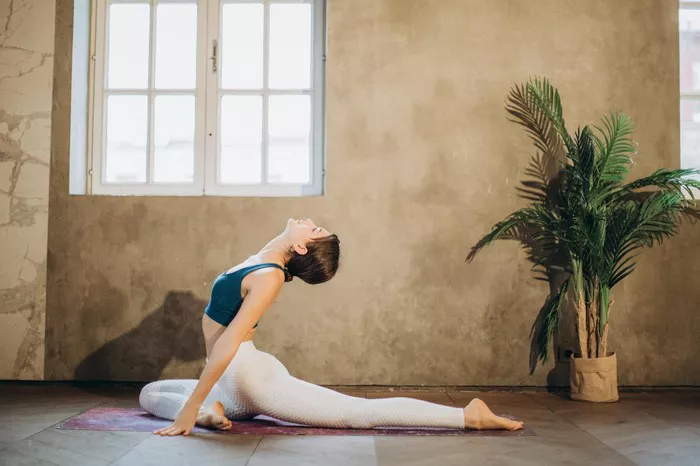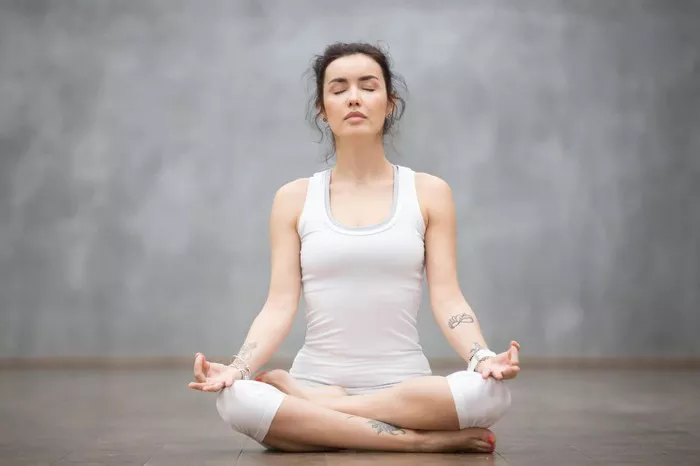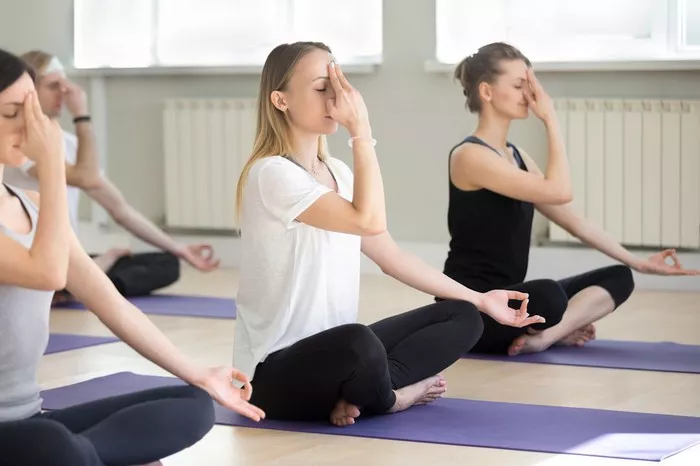Understanding Power Yoga
Power Yoga, often referred to as “Vinyasa” or “Flow Yoga,” is a dynamic form of yoga that seamlessly blends breath with movement. Originating from Ashtanga Yoga, Power Yoga ditches the rigid structure of its predecessor and embraces a more creative and adaptable approach. The practice is characterized by a continuous flow of postures, each synchronized with the breath, fostering a harmonious connection between mind and body.
1. Dynamic Sequencing: Power Yoga typically involves a series of poses arranged in a sequence, promoting strength, flexibility, and balance. The fluid transitions between poses create a cardiovascular workout, elevating the heart rate and improving overall fitness.
2. Breath Awareness: Central to Power Yoga is the emphasis on conscious breathing, or “Ujjayi breath.” This deep, audible breath not only oxygenates the body but also serves as a moving meditation, calming the mind and enhancing focus.
3. Strength Building: Unlike some other yoga styles that focus primarily on static poses, Power Yoga challenges practitioners to engage their muscles continuously. This leads to improved muscle tone, increased endurance, and enhanced functional strength.
4. Adaptability: One of the defining features of Power Yoga is its adaptability. Practitioners can tailor the practice to their individual needs, making it suitable for various fitness levels and personal goals.
Benefits of Power Yoga at Home
While attending a yoga studio has its merits, cultivating a Power Yoga practice at home offers unique advantages that cater to the demands of a busy lifestyle.
1. Flexibility in Schedule: Home practice eliminates the need to adhere to studio class schedules. Whether you’re an early riser or prefer an evening session, practicing at home allows you to tailor your yoga routine to your daily schedule.
2. Cost-Effective: Attending studio classes can be expensive, but establishing a home practice requires minimal investment. A good quality yoga mat, comfortable clothing, and perhaps a few instructional resources are all you need to get started.
3. Personalized Environment: Your home provides a familiar and comfortable environment, free from the distractions often present in a studio setting. This personalized space allows you to focus on your practice without external influences.
4. Increased Consistency: With no commute to a studio, the barriers to consistent practice are significantly reduced. This increased accessibility fosters a habit of regular practice, maximizing the benefits of Power Yoga over time.
Setting Up Your Home Yoga Space
Creating a dedicated space for Power Yoga at home is essential to establish a consistent and focused practice. Follow these steps to design a yoga-friendly environment within the confines of your home.
1. Choose a Quiet Space: Select a room or corner that is free from distractions and noise. This could be a spare room, a cozy corner in your living room, or even a section of your bedroom.
2. Natural Light and Ventilation: Whenever possible, opt for a space with ample natural light and good ventilation. These elements contribute to a positive and energizing atmosphere for your practice.
3. Invest in Essential Equipment: While Power Yoga doesn’t require extensive equipment, investing in a high-quality yoga mat is crucial. Additionally, props such as blocks and straps can enhance your practice and provide support as needed.
4. Personalize Your Space: Add elements that inspire and motivate you. This could include plants, inspirational quotes, or soothing colors. Creating a space that resonates with you makes it more likely that you’ll look forward to your practice.
Crafting a Home Power Yoga Routine
Now that your space is set up, it’s time to design a Power Yoga routine tailored to your preferences and goals. Follow these guidelines to create a well-rounded and effective practice.
1. Warm-Up with Sun Salutations: Begin your practice with a series of Sun Salutations to warm up the body and synchronize your breath with movement. This dynamic sequence prepares your muscles for the more challenging poses ahead.
2. Include Standing Poses for Strength: Integrate standing poses such as Warrior series, Chair Pose, and Crescent Lunge to build lower body strength and stability. These poses also enhance balance and focus.
3. Incorporate Balancing Poses: Balancing poses like Tree Pose and Eagle Pose not only strengthen the core and lower body but also improve concentration and mental focus.
4. Embrace Inversions and Arm Balances: Challenge yourself with inversions like Headstand or Arm Balances like Crow Pose. These poses build upper body strength, enhance coordination, and boost confidence.
5. End with Cooling Poses and Savasana: Wind down your practice with cooling poses like Forward Folds and Pigeon Pose to stretch and release tension. Conclude with Savasana, allowing your body and mind to absorb the benefits of your practice.
Utilizing Online Resources for Guidance
For those new to Power Yoga or seeking guidance in their home practice, online resources can be invaluable. Numerous platforms offer classes led by experienced instructors, providing the structure and guidance needed to progress in your practice.
1. Online Yoga Classes: Platforms like YogaGlo, Glo, and YouTube offer a plethora of Power Yoga classes for practitioners of all levels. These classes range from short, targeted sessions to longer, more comprehensive practices.
2. Virtual Workshops and Challenges: Joining virtual workshops or challenges led by renowned Power Yoga instructors can deepen your understanding of the practice. These events often include detailed tutorials, alignment tips, and opportunities to connect with a supportive community.
3. Yoga Apps: Mobile apps dedicated to yoga, such as Asana Rebel and Daily Yoga, offer curated Power Yoga routines. These apps often feature customizable workouts, progress tracking, and reminders to help you stay consistent.
Overcoming Challenges in Home Practice
While practicing Power Yoga at home is incredibly rewarding, it comes with its own set of challenges. Addressing these obstacles head-on ensures a sustainable and enjoyable home practice.
1. Self-Motivation: Without the external motivation of a studio environment, self-discipline becomes paramount. Establish a consistent practice by setting realistic goals, creating a schedule, and finding joy in the process.
2. Distractions: Home environments can be full of distractions, from household chores to electronic devices. Designate specific times for your practice and communicate your boundaries to those sharing the space with you.
3. Lack of Feedback: In a studio setting, instructors provide real-time feedback to ensure proper alignment and technique. To overcome this challenge at home, use mirrors, record your practice, or attend virtual classes where instructors offer corrections.
4. Stagnation in Practice: To prevent your practice from becoming monotonous, regularly explore new sequences, poses, or styles of Power Yoga. This not only keeps things fresh but also challenges your body and mind to adapt and grow.
The Transformative Power of Consistency
Consistency is the key to unlocking the transformative power of Power Yoga. Establishing a regular home practice requires commitment and dedication, but the rewards are profound.
1. Physical Transformation: Over time, consistent Power Yoga practice results in increased strength, flexibility, and endurance. Muscles become toned, and the entire body experiences a heightened sense of vitality.
2. Mental Clarity and Focus: The combination of breath awareness and dynamic movement in Power Yoga cultivates mental clarity and focus. This heightened awareness extends beyond the yoga mat, positively impacting various aspects of daily life.
3. Stress Reduction: Power Yoga serves as a potent stress reliever, helping to release tension from the body and calm the mind. The meditative aspect of the practice contributes to a sense of inner peace and balance.
4. Enhanced Mind-Body Connection: As you progress in your Power Yoga journey, you’ll develop a profound connection between your mind and body. This heightened awareness allows you to respond intuitively to your body’s needs, fostering overall well-being.
Conclusion
Power Yoga at home is a powerful and accessible means of cultivating physical strength, mental resilience, and holistic well-being. By understanding the principles of Power Yoga, creating a dedicated home space, crafting a personalized routine, utilizing online resources, and overcoming challenges, you can embark on a transformative journey that empowers your body and mind. Consistency is the catalyst for change, so embrace the practice with dedication and let the transformative power of Power Yoga unfold in the comfort of your own home.






















